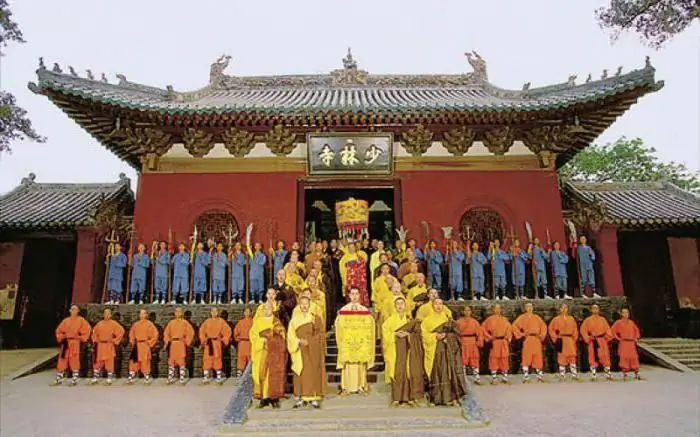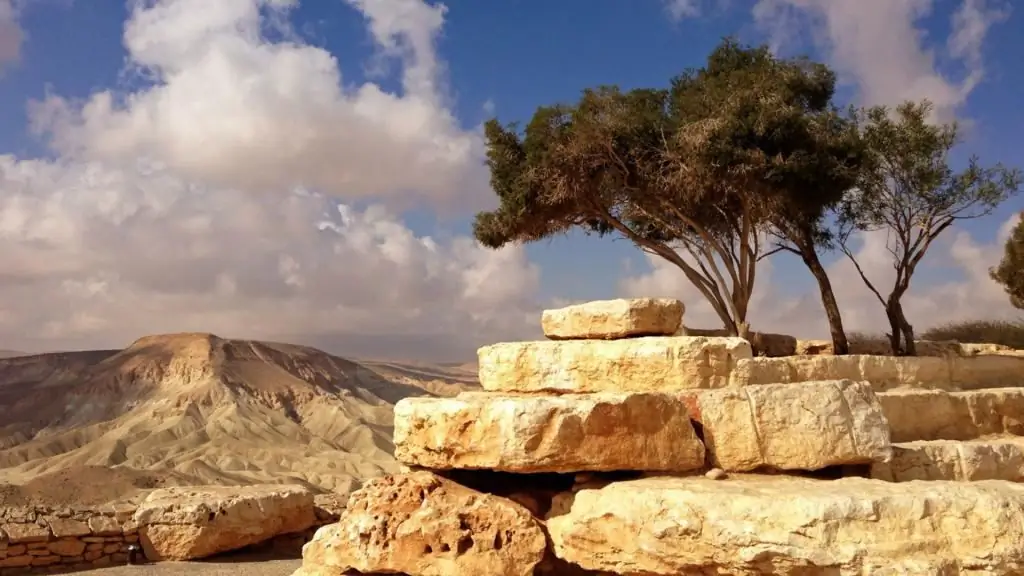- Author Harold Hamphrey [email protected].
- Public 2023-12-17 10:06.
- Last modified 2025-01-24 11:10.
Sights of the Dmitrovsky district of the Moscow region are distinguished by their considerable age, good study and proximity to no less interesting objects that you will meet while traveling north from the capital. The Dmitrovsky district includes eleven municipalities, of which the largest are the cities of Dmitrov and Yakhroma. The area of the district is just over 200 thousand hectares, the population is 162 thousand people.
History of the region
Development of the territory began a long time ago. According to archaeologists, the appearance of man in these parts dates back to the late Mesolithic era. The site of a primitive man was found near the village of Davydkovo, on the banks of the Yakhroma River. People here were engaged in hunting, fishing, gathering. Eastern Slavs began to actively populate this territory in the 18th-19th centuries. A dense forest grew here, people settled alongbanks of rivers or near them, clearing glades from the forest.
Dmitrov
The main city and the main attraction of the Dmitrovsky district of the Moscow region. It was founded in 1154 by Yuri Dolgoruky, Prince of Rostov-Suzdal, as a frontier fortress. Soon the new city acquired not only strategic importance. Being at the crossroads of trade water and land routes, it began to develop rapidly economically and acquired a new significance for the principality. Along the rivers Yakhroma, Sestra and Dubna, merchants sailed to the upper reaches of the Volga, and by land it was possible to get to the Klyazma, and from there to Vladimir.

The city was at the crossroads of not only trade, but also military routes. Repeatedly ruined by specific princes, the Golden Horde, raids of nomadic tribes, it was rebuilt again and remained on guard of the princely borders.
The event of 1364, when Dmitrov became part of the Moscow Principality, is of great importance for the city. The peaceful period, which dates back to the beginning of the 15th century, contributed to its economic development, population growth, and prosperity. It was at this time that objects began to be built, which today are the sights of the Dmitrovsky district of the Moscow region.

Periods of growth alternated with years of crises and ruins, but a steady growth in trading activity began thanks to the reforms of Peter I. With the advent of St. Petersburg, the construction of manufactory facilities, industrial establishments began in the city: a tallow plant, a s alt factory, tanneries. near the cityappeared its coat of arms.
The construction of the railway line connecting Moscow with St. Petersburg reduced the importance of the old waterway, and the city once again began to fall into decay. The city's population also began to decline. Another leap upwards is associated with the construction of the Moscow Canal in 1932-1938. The population immediately tripled.
During the war, heavy battles unfolded on the front near the city of Dmitrov, the purpose of which was to destroy the hydraulic system and cut off the supply of electricity to Moscow. Channel them. Moscow, Peremilovskaya height, located south of Dmitrov, are the sights of the Dmitrovsky district, the description of which we will consider below.
Currently, the city boasts well-maintained residential areas, well-groomed streets and parks, restored historical sites. In 2005, he took the Grand Prize at the All-Russian competition "The most comfortable city in Russia" in the category of cities with a population of up to 100 thousand people.
About the sports attractions of the Dmitrovsky district. Travel Tips
When driving along Dmitrovskoye Highway by car or bus, you will repeatedly come across signs to sports facilities, which are numerous in these places. On the slopes of the picturesque Klinsko-Dmitrovskaya ridge there are numerous tracks, ski slopes, ski routes begin here.
Complex "Volen", located on the 63rd kilometer of the Dmitrov highway, two kilometers from the city of Yakhroma, is famous among fans of ski slopes for interesting tracks of variouscomplexity, developed infrastructure, good coaching staff. There are 16 lifts here. But it should be noted that this fashion complex is quite expensive.
The Yakhroma ski slope is rich in entertainment for every taste: ten illuminated slopes, a skating rink, snowmobiles, a winding toboggan (a track with turns and turns along which they move in special carts) will delight both children and adults.

"Sorochany" is a well-equipped sports complex, no worse than "Volen". But the prices here are still significantly different from the expensive complex, perhaps this is due to the lower publicity of the object.
Moscow Channel
Moving towards Dmitrov along the Dmitrovsky highway, the traveler will travel along this hydraulic structure, which is an interesting attraction of the Dmitrovsky district, for a considerable distance. Describing the beauty and significance of the waterway that made Moscow the port of the five seas would take a long time. It will be more informative to characterize its national economic significance.

The decision to build the canal was made by the Soviet government in 1931, and six years later the first ships left Nizhny Novgorod for the capital of the USSR. Two problems were solved at once: two mighty rivers, Moscow and Volga, were connected, and the capital was provided with Volga water, since Moskvoretskaya was already sorely lacking. 128 kilometers of the canal stretched from Dubna to the Tushinsky district of Moscow.
BesidesThe canal provides sanitary watering of the Moskva River, is the shortest transport direct from the capital to the Volga, provides the city and adjacent settlements with electrical energy.
Five reservoirs that appeared on the map in connection with the construction of the canal: Ikshinskoye, Pestovskoye, Uchinskoye, Pyalovskoye and Klyazminskoye are not only recreational areas for Muscovites, but also storage reservoirs of drinking water for the city.
Yakhroma
A small town located 55 kilometers from Moscow on the banks of the Moscow Canal. Tourists are amused by the old legend about the origin of the name of this settlement. Allegedly, accompanying the Grand Duke Vsevolod to the construction site of Dmitrov, the wife stumbled, getting out of the wagon, and capriciously declared: “I am lame.”
The area of the city is only 17 km22, less than 15 thousand people live here. But, despite its small size, there is something to see in the city. The attractions of the Dmitrovsky district are the Trinity Cathedral, which rises in the old part of the city, as well as the gateway number 3 on the Moscow Canal.

Columbus' "Santa Maria" caravels, made of red copper, are mounted on the towers of the lock chamber and burn in the sun, attracting attention from afar. Here was the line of defense of the capital in December 1941.
Dmitrovsky Kremlin. Groundwall
You should start your acquaintance with the city from the territory of the Kremlin. Here in the XII century there was a wooden fortress, erected by order of Yuri Dolgoruky to protect Moscowlands. A witness of the events of those times has been preserved - an earthen rampart, which is one of the main attractions of the Dmitrovsky district.

It is 990 meters long and up to 14 meters high. Once upon a time, wooden walls with towers rose on its top, but the tree burned down or rotted, and the rampart remained. Today this historical monument is protected by the state.
Assumption Cathedral of the Kremlin
Assumption Cathedral, which is the dominant feature of the Kremlin, was rebuilt many times. Now it is difficult to imagine how he looked at first. It is known that he was crowned with five chapters, today there are nine of them. The exact date of construction is unknown, but it is the first half of the 16th century. The cathedral was in good condition before reconstruction, because in 1932 it was transferred to the local museum. True, at the same time they removed the crosses, dismantled the dome and the spire of the bell tower. But in 1991, handed over to the church, the temple was restored and has been operating since 2003.
Monuments in the Kremlin
There are monuments on the territory of the Kremlin that can hardly be called sights of the Dmitrov region, but they are definitely interesting. In front of the entrance to the Assumption Cathedral there is a monument to the Hieromartyr Seraphim, who in the twenties of the last century founded the brotherhood of the Life-Giving Cross of the Lord and "was engaged in counter-revolutionary activities." The fate of the "enemy of the people" awaited him. In 2004, a monument to Cyril and Methodius, the creators of Slavic writing, was erected on the territory. The attitude towards them here is reverent, their images can also be seen in the temple.

There are still many interesting, well-repaired objects on the territory of the Kremlin, which generously share the history of these places.
Peremilovskaya height of 214 meters
Just one and a half kilometers from the city there is another significant attraction of the Dmitrovsky district, the photo of which is often printed on city posters, booklets, guidebooks.

In 1941, bloody battles took place in these places for a strategically important height, today a memorial complex was erected here in memory of the defenders of this extremely important line. From here, the retreat of the fascist invaders began.






